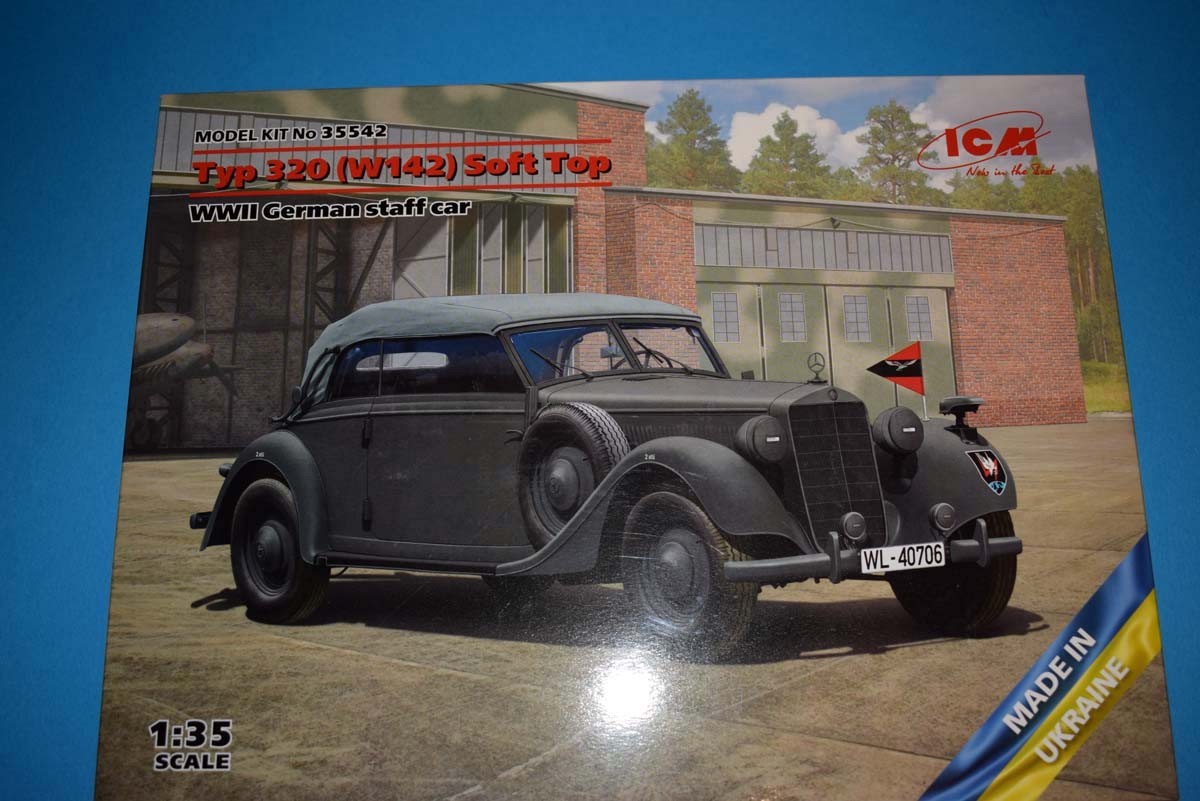
Introduction
The following introduction is taken from the ICM website:
The Mercedes-Benz 320, also known as the W142, was developed at the design bureau of Daimler-Benz AG and began production in 1937. It had a six-cylinder engine with a volume of 3.2 litres (3.4 litres in later versions) and 78 horsepower. The model was available with a short (2880 mm) or long (3300 mm) wheelbase and various body styles. The Cabriolet body variant was available in a long wheelbase version. The four-seater version had two doors and four side windows; the roof was soft and could be folded down to protect it from the weather. This vehicle was often seen in the Wehrmacht, with some retaining civilian license plates. It was used as a staff car and was also used to transport senior commanders.
Review
This offering from ICM arrives in a flip top cardboard box with a separate card lid showing the artwork. Inside the model is packaged in a single re-sealable bag, with 2 further bags inside containing the wheels and clear parts. The moulding of the various elements is good, with no obvious flash present and good access for removal of the parts from the sprue. The size of the gates is acceptable, and the quantity of them is reasonable. In typical ICM fashion, a very pleasing representation of the engine and gearbox, plus the cooling system is nicely replicated. One of the high points of ICM kits for me is that the items of the kit provided lend themselves to showing a damaged or destroyed vehicle. On the down side, ICM has a habit of not allowing the display of these pleasing inclusions, which only really require the modeller to supply some cables. Due to the fact that photo etch is not normally supplied in ICM offerings, some parts of the engine maybe over scale, but it is very rare for these parts to disappoint me.
The chassis is a multi part moulding with an unusual overlap design, I would be concerned usually about getting the chassis assembled squarely, but in this case a large moulding at the rear that accommodates the rear axle takes away any concerns I would normally have, and a brace 2/3rds towards the front of the chassis sets it. Two further cross members finally secure the chassis rails for the addition of the various oily elements. Rear axle detail is very good, but the front axle disappoints me, as you do not have the option to show the wheels turned. Another aspect that may disappoint is that the tyres on the model are vinyl rubber, which is known to be unpopular with many modellers due to the risk of the rubber breaking down due to the chemicals we use to weather things. The suspension of the vehicle is set which is fine. The fuel tank is provided at the very rear of the vehicle, and has a decent level of detail.
The floor panel of the model attaches directly to the chassis and so makes clear the importance of getting the chassis rails correctly orientated. The fire wall between the engine and cab has good detail on the engine side and the cab side is obscured due to the instrument panel that is present and has decals for the instrument pinnacles. The steering column has been provided within the engine bay. The vehicle is a 4 seater, and I am not a fan of pristine seats being shown in a model, but with being a staff car I can make an exception. This vehicle is a 2 door vehicle and I have to say that I am a little surprised that a staff car would not have its own doors for the passengers.
The panels making up the side of the car has a separate door cards and extend from the middle of the rear wheel arch to the radiator grille. The radiator grille is an aspect of the model that is pleasingly represented. The hood of the model prevents you from accurately showing it open as it is one of those that lifts from the side to the centre. The glazed aspects are suitably thin and fulfil their function. The lights on the vehicle all have clear lenses and a shielded headlight is also included in the kit. Despite not being photo etch, the wiper blades are also individually moulded. The soft top hood is I believe a new part of this release, and is very visually pleasing on the outside, but there are 4 distinct ejector pin marks which will need to be addressed despite not being easily seen. The decal sheet has good colour, with clean demarcation and I can only just feel them on the carrier film. ICM has provided 4 finishing options for this release, and these are:
Typ 320 (W142) Cabriolet, France, 1940
Typ 320 (W142) Cabriolet, Unkown Luftwaffe Unit, 1940
Typ 320 (W142) Cabriolet, Eastern Front, 1943
Typ 320 (W142) Cabriolet, NUG1 (Machtjagdgeschwader 1), probably 1943
Review
This release from ICM is generally pleasing looking at the part detail. I am going to overlook the vinyl rubber tyres as this aspect is a matter of preference. I do feel that the addition of some photo etch which could lift the model to a higher degree. The inability to show the engine and gearbox is disappointing, but as regards general detail overall and looking at a few on line images I could find, it visually appears to be accurate.

